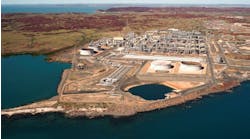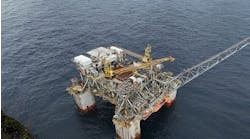ExxonMobil’s Lena platform jacket reefed in the Gulf of Mexico
Offshore staff
NEW ORLEANS – The Bureau of Safety and Environmental Enforcement (BSEE) has approved the conversion of ExxonMobil’s Lena compliant tower platform into an artificial reef under its Rigs-to-Reefs Program.
On July 3, 2020, the Lena platform jacket was toppled-in-place to create a new reef site in the Gulf of Mexico outer continental shelf. BSEE approved the jacket reefing procedure after reviewing ExxonMobil’s platform removal application.
The Lena platform is now the tallest oil and gas platform in the Gulf of Mexico to become a deepwater reef, according to BSEE.
The Lena platform is about 50 mi (80 km) southeast of Grand Isle, Louisiana, in Mississippi Canyon block 280. Installed in 1983 in 1,000 ft (304.8 m) of water, it was said to be the world’s first cable-stabilized production platform in the Gulf.
The structure was originally 1,078 ft (328.6 m) tall and weighed 27,000 tons. With the decks and drilling rig added, the Lena stood 1,300 ft (396.2 m) tall – 50 ft (15 m) higher than the Empire State Building. It enjoyed a productive 35-year life span, generating revenue from oil and natural gas sales through 2016. Its decommissioning began in 2017.
BSEE and ExxonMobil have been working with the Louisiana Department of Wildlife and Fisheries (LDWF) on the decommissioning and proposed reefing of the Lena platform for more than five years, the bureau said. The LDWF will be the manager and owner of the Lena platform jacket after the site has been surveyed and cleared, most likely in early 2021.
Keith Matocha, decommissioning project manager at ExxonMobil, said: “As an artificial reef, the Lena will benefit the environment by continuing to provide habitats for rare Gulf of Mexico deepwater coral and various encrusting organisms that attract fish and other marine life found on natural reefs.”
The Rigs-to-Reefs Program was developed by the Minerals Management Service, BSEE’s predecessor agency, after it became official federal policy in the mid-1980s under the National Artificial Reef Plan.
Since 1987, the bureau has approved more than 500 rigs-to-reefs projects in the Gulf, with 47 of those in the last three years.
10/09/2020



